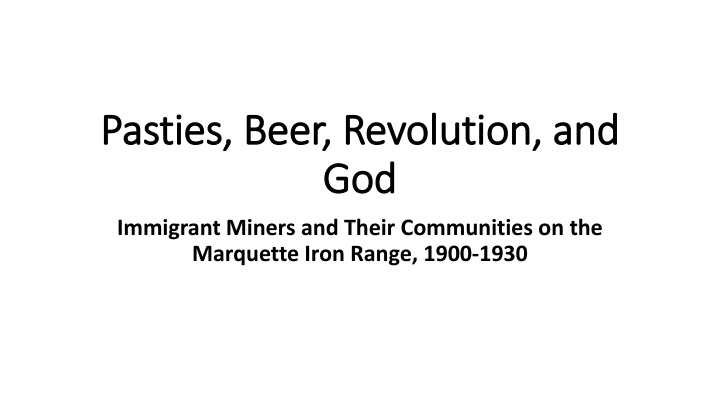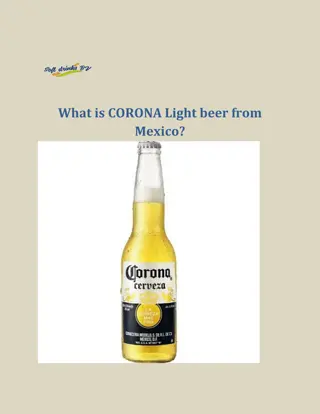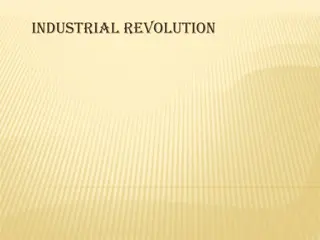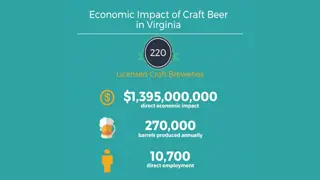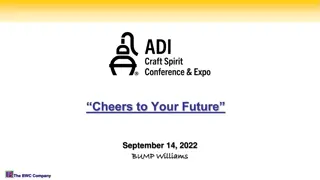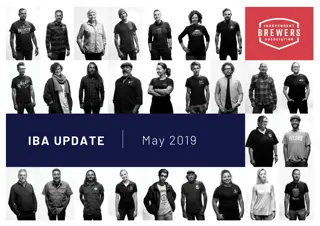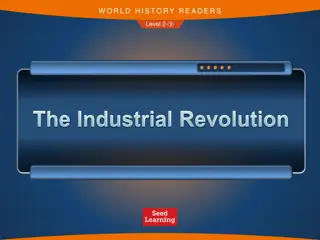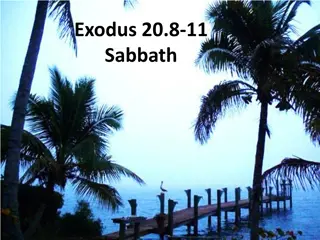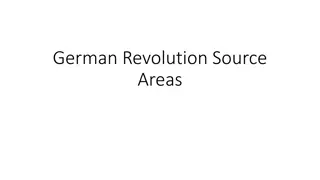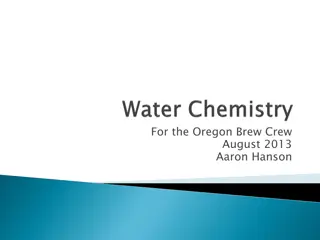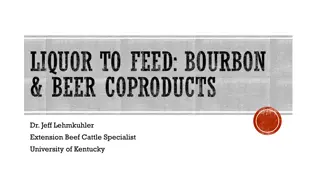Pasties, Beer, Revolution, and Pasties, Beer, Revolution, and God
Immigrant miners faced challenges and labor strife on the Marquette Iron Range between 1900-1930. The arrival of Cornish and Finnish miners, strikes, economic depressions, and the rise of labor movements characterized this period. The involvement of Industrial Workers of the World (IWW), Socialist Party of America, and labor wars like the Colorado Labor Wars and Copper Country Strike influenced the mining communities. Despite hardships, these communities adapted, leading to changes in population demographics and economic diversification.
Uploaded on Mar 07, 2025 | 0 Views
Download Presentation

Please find below an Image/Link to download the presentation.
The content on the website is provided AS IS for your information and personal use only. It may not be sold, licensed, or shared on other websites without obtaining consent from the author.If you encounter any issues during the download, it is possible that the publisher has removed the file from their server.
You are allowed to download the files provided on this website for personal or commercial use, subject to the condition that they are used lawfully. All files are the property of their respective owners.
The content on the website is provided AS IS for your information and personal use only. It may not be sold, licensed, or shared on other websites without obtaining consent from the author.
E N D
Presentation Transcript
Pasties, Beer, Revolution, and Pasties, Beer, Revolution, and God God Immigrant Miners and Their Communities on the Marquette Iron Range, 1900-1930
100 Bottles of 100 Bottles of Beer Beer. . . . . .
The Failure of The Failure of Cornish Pasties Cornish Pasties: Marquette Iron Range, Cornish miners began arriving after 1880 (eschewed open-pit mining). Never more than 25% of miners. 1909 dropped to 13%. Mining foremen, captains, etc .. Depression 1893 (workforce dropped from 17,000 to 3,500, causing massive out migration) Strike of 1895 (3,000 miners; state militia; independent union led by Cornish) Strike of 1899 (2,700 miners; split between Cornish and Finnish miners) : Marquette Iron Range, 1890 1890 - - 1900 1900 1895 Strike Parade, Ishpeming
Revolution! Revolution! Industrial Workers of the World, 1905, (IWW) and the Western Federation of Miners (WFM), 1893 Socialist Party of America. Won over 900,000 votes 1912 and 1920 (E. Debs ran for president from prison) Bolshevik revolution in Russia (1917) Seattle General Strike (1919) Anarchist bombings (Sacco and Vanzetti, 1920) Palmer Raids (1919) 6,000 arrested and 556 deportations
Revolution Revolution: Hard Rock Mining Labor Wars, 1900 : Hard Rock Mining Labor Wars, 1900 1930 1930 Colorado Labor Wars, 1903-1904. Led by the WFM. Involved thousands of miners and intervention by the state militia, US Army, Pinkertons Mesabi Iron Range Strikes, 1907 (WFM), 1916 (IWW). Struck for better pay and 8 hour day. Copper Country Strike, 1913-1914 (WFM, IWW. Last 265 days) Butte Montana Labor Riots, 1914 (Conflict between IWW and WFM for control. Involved blacklisting of Finnish miners) Anaconda Road Massacre, 1920 (IWW s last major effort in the western copper mines) CCI Miners, 1917
Marquette Iron Range Labor Strife, 1900 Marquette Iron Range Labor Strife, 1900- -1946 1946 Why?
Martin Hendrickson (1900), NYC editor of the American Worker. Renowned socialist agitator. Atheist, anti-church, horned devil. Large population decline: 13,255 (1900) to 9,238 (1930). 31 percent Foreign born population decreased 53 percent Finnish born population decreased 29.2 percent (1910-1920) More diversified economy (Gossard) Nine-tenths of population lived scattered in and around downtown area. Single family units accounted for 80% residential structures. Multiple dwellings, 2% Settled Communities: Ishpeming Settled Communities: Ishpeming Forced the more adventurous men to seek employment elsewhere, and so has steadied and sobered the life of the community Joe R. Whitaker (1931) Ishpeming from Knob Hill, 1930
Settled Communities: Negaunee Settled Communities: Negaunee Population decline: 8,460 (1910) to 6,552 (1930). 23 percent Ratio of men to women: 1.9 (1910) to 1.3 (1930) Foreign born: 47.6 percent (1910) to 33 percent (1930) A culture of self-sufficiency. Part-time Farmers. 3-6 percent of miners farmed land. CCI opened plots of 15,000 square feet to truck farming Iron Street, 1909
Community Cohesion: The Locations Community Cohesion: The Locations Spring Street Location Bancroft Location
Image:FinnishCivilWarMapBegin.jpg Finnish Immigration to Finnish Immigration to Marquette County, 1905 Marquette County, 1905- -1920 1920 1880s First Wave (Rural) of Finnish immigration. 1904 Second Wave (Urban) Russification and political repression. Marquette Iron Range No Second Wave: 80% (550) green region (rural) 20% (138) red region (urban) No one from Helsinki Vihtori Tyynismaa Kortesjarvi Toivo John Karell Vaasa
Decline in Finnish Born Population, 1900 Decline in Finnish Born Population, 1900- -1930 1930 1910 Populaton Characteristics 7,000 6,000 39.8% of foreign born population 57% miners (Ishpeming) 55% miners (Negaunee) 5,000 4,000 3,000 2,000 1,000 0 1900 1910 1920 1930 Finnish Born
Immigration from South and Central Europe, 1900 Immigration from South and Central Europe, 1900- -1930 1930 1400 1200 Italian immigration begins to increase significantly in 1890 (1910) Italians comprise 16% of miners on the Marquette Iron Range (1920) 87% identified as miners. Mostly labors and trammers 1000 800 600 400 200 0 1900 1910 1920 1930 Italy Poland Russia Austria
Revolution Revolution Failed: the Battle for the Negaunee Failed: the Battle for the Negaunee Labor Temple, 1913 Labor Temple, 1913 The Socialistic Finn The Labor Temple (1910) The Finnish Socialist Federation (1906) Anarcho-Syndicalism (William Risto) vs. Parlimentarism (Frank Aaltonen) Labor Temple, Thunder Bay, Ontario
Counter Counter - - Revolution Revolution Finnish Republican Club. 350 members
God God: Finnish Evangelical Lutheran Church of America Finnish Evangelical Lutheran Church of America 1910 Membership: 2,284 (45% of Finn population) 1920 Membership: 2,994 (65% of Finn population) Replicate the Church of Finland in the Lake Superior region. Traditionalist, conservative, and favored a paternalistic church and clergy Many prominent Finnish business men participated in the formation, 1899 Actively adopted a strategy of accommodation with corporate capitalism. Vehemently anti- socialist. 240 people signed anti-socialist resolution following 1907 Mesabi Strike
The Fear of The Fear of God God 3,000 2,500 2,000 1,500 1,000 500 0 1905 1910 1915 1920 Comparison of Suomi Synod LutheranChurch Membership, 1905-1920
William Mather / Progressive Era (Speech to the Lake Superior Iron Mining Association, 1898) Skip to Potty Letters Low rental housing and support for ownership (CCI owned 600 houses) Community clubhouses and beautification awards Pension Plan (1909) Establishment of Gwinn as a model company town (1907) Gwinn Records Company sponsored health care Nurses Reports Visiting doctor and nurse program Company maintained hospital (Ishpeming, 1918) Company Initiated Safety Program (1911) CCI s Corporate Paternalism CCI s Corporate Paternalism
The The Potty Potty Letters Letters
Hard Work: CCI Fatalities, 1898 Hard Work: CCI Fatalities, 1898 - - 1940 1940 70 60 50 40 30 Fatalites Fatality Rate 20 10 0 Total CCI Fatalities: 321 (1926 does not include Barnes-Hecker) Total Marquette Iron Range Fatalities: 675 Mesabi Range Death Rate 7.5 / 1000
Hard Work: Deaths by Ethnicity Hard Work: Deaths by Ethnicity Time English Finnish Swede Irish American Italian 1900-1909 41 78 20 2 2 22 1910-1919 28 78 7 2 9 23 1920-1929 4 13 1 2 5 6 1930-1940 1 8 0 0 5 5
Hard Work: Reason for Poor Safety Record Hard Work: Reason for Poor Safety Record (Prior to 1911) Poor discipline in the mines Contract System (Cornish practice) Company paid a work team according to output. Worked fast, little oversight. Demand for labor greater than supply (inexperienced miners) Lack of laws forcing compensation for fatalities Employee carelessness Lake Angeline Mine, Marquette Iron Range
] 8 7 6 5 4 Average Wage per Day Cost of Production per Ton 3 2 1 0 1909 1910 1912 1913 1914 1915 1916 1917 1918 1919 1920 Cliffs Shaft Mine: Average Daily Wages and Cost of Production, 1909- 1920
The Second Klan Movement Inspired, in part, by Thomas Dixon s novel, The Clansman (1905), and D.W. Griffith's film Birth of a Nation (1915) Founded in Atlanta, Georgia (1915) Nativist, xenophobic, petty nationalism Enjoyed wide-spread support, especially in the mid-West and Western states. By 1925, the KKK reputedly had 4.5 million members. A successful third party KKK March on Washington, 1925.
Protestant Hegemony Large influx of immigration from southern and central Europe Virulent anti-Catholicism and anti-Semiticism Allegiance to papal authority Prohibition violation, sexual immorality, threats to religion and traditional family values.
Anti-Immigration Legislation The Quota Law of 1921 restricted annual immigration to approximately 350,000 persons. Limited annual immigration from any one country to 3% of 1910 numbers. Immigration Act of 1924. By 1930, annual immigration limited to 150,000. Disproportionate by ethnicity and country of origin. Asians completely excluded. Northern European: 86.5 % Southern / Central Europe: 11.2 %
